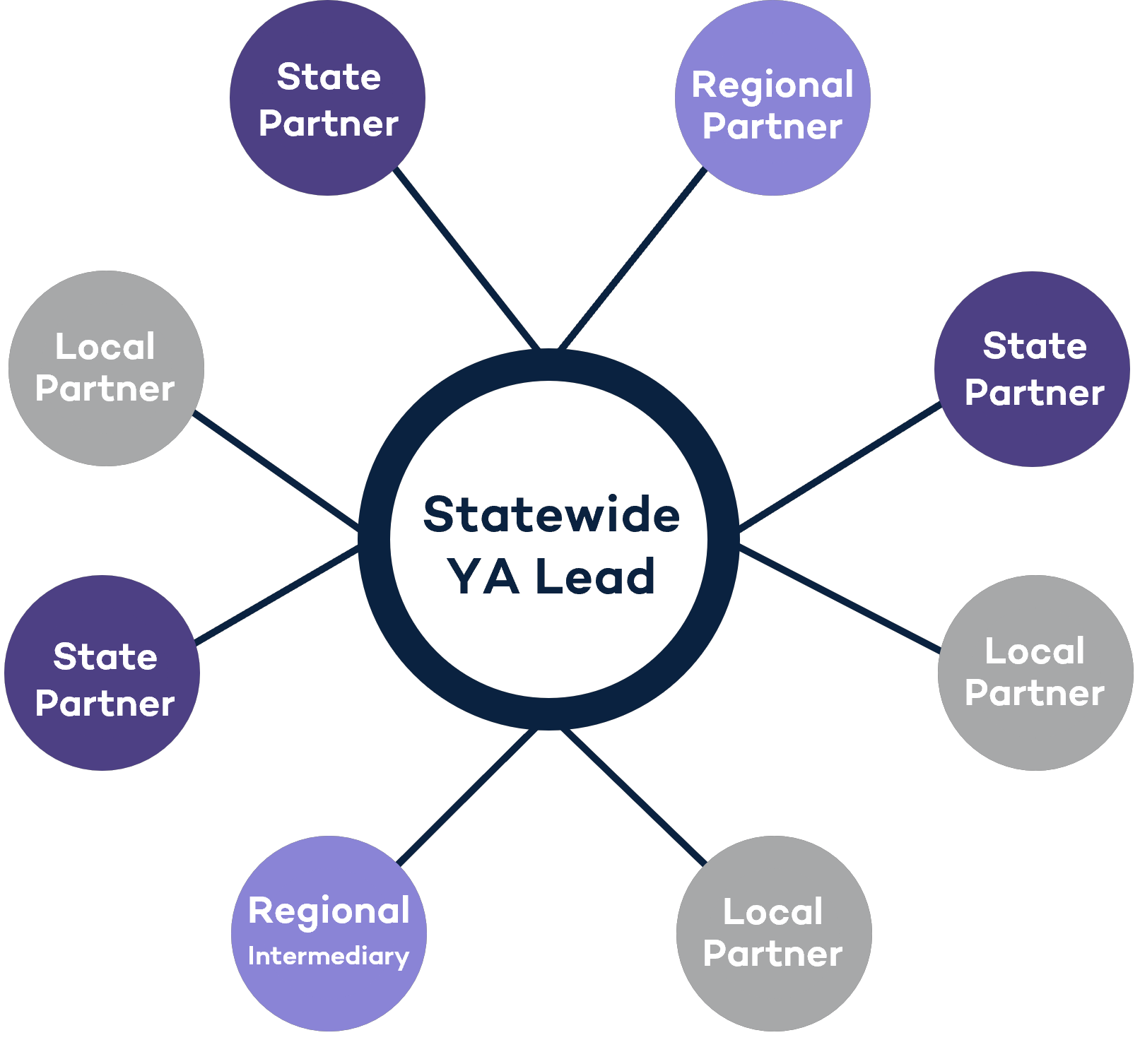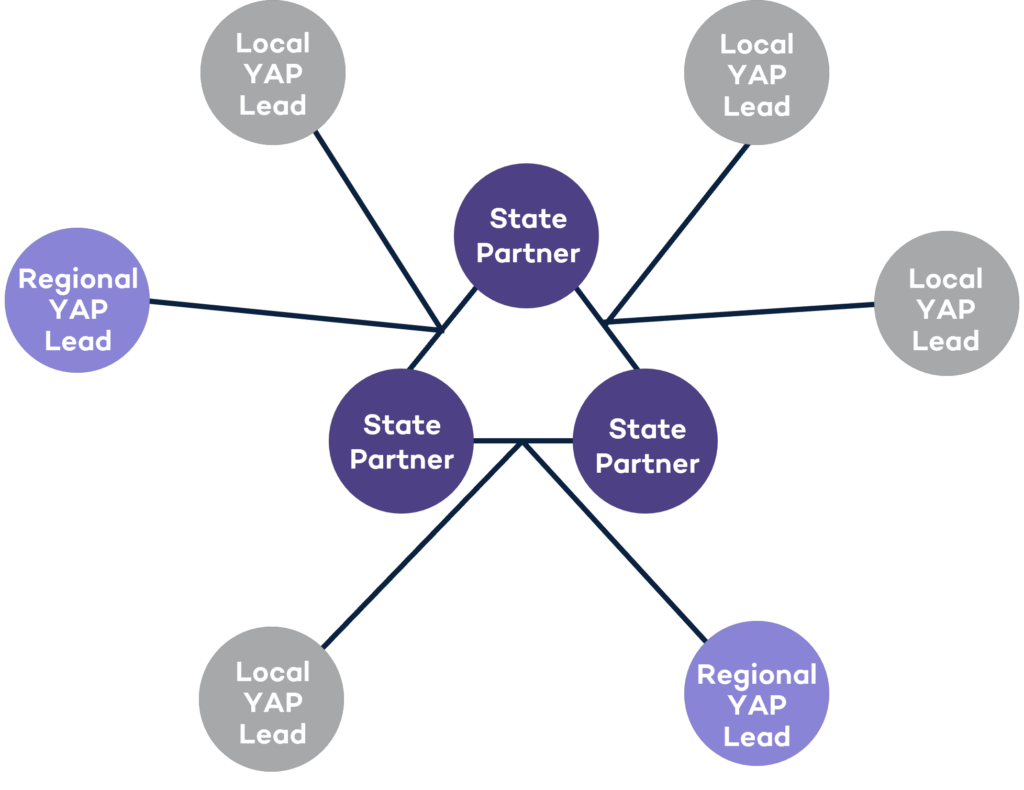In most states, youth apprenticeship systems are relatively new and are still evolving in response to the needs of students, employers, and partners.
(Download)
The National Governors Association Center for Best Practices (NGA Center) is a national partner in the Partnership to Advance Youth Apprenticeship (PAYA), a multiyear collaborative created by New America in 2018 to help states and cities expand access to high-quality apprenticeship opportunities for high school age youth. In August 2023, the NGA Center launched the Policy Academy to Advance Youth Apprenticeship, a yearlong project to support state teams from Alabama, Colorado, Indiana, Kansas, North Carolina, and Utah as they develop policy agendas that advance these opportunities.
Youth apprenticeship programs exist at the intersection of education and workforce development, serving young people and employers by connecting the learning needs of youth with the talent needs of industry. To scale these high-quality programs, states must make key considerations on systems design that promote alignment between partners, define roles and responsibilities, and provide students and other key stakeholders with transparency in what can often be a confusing and duplicative landscape.
PAYA’s Definition of High-Quality Youth Apprenticeship
High-quality youth apprenticeship programs mirror the criteria for high-quality registered apprenticeships. The four elements of a high-quality youth apprenticeship, as identified through PAYA partners’ research, are:
- Paid, on-the-job learning under the supervision of skilled employee mentors
- Related classroom-based or technical instruction
- Ongoing assessment against established skills and competencies
- Culmination in a portable, industry-recognized credential and postsecondary credit
YOUTH APPRENTICESHIP STATE SYSTEMS
Youth apprenticeship programs require the participation and support of several entities that may not be adequately aligned to uplift and sustain youth apprenticeship. Youth apprenticeship systems are often comprised of state workforce agencies, state education agencies, local education agencies, postsecondary education providers, employers, intermediaries, and community-based organizations. A clear system is paramount to ensure programs across the state are high-quality and responsive to both youth apprentices’ and employers’ needs. Youth apprenticeship systems generally operate along a continuum of being entirely centralized or decentralized. While both models can be successful, policymakers must consider the existing policy landscape when making key structural decisions for their youth apprenticeship systems.
Centralized
Under this model, all youth apprenticeship programs in the state are coordinated, approved and tracked under one system. The agency leader of this system might partner or cooperate with other agencies, but they are ultimately accountable for youth apprenticeship in the state. Responsibilities may include directing the rules and regulations for youth apprenticeship programs as well as managing and overseeing activities such as training agreements, marketing and outreach and other duties.

Decentralized
Under this model, youth apprenticeship programs are developed and executed by various partners. Roles such as registering and approving programs, executing training agreements, conducting marketing and outreach, and data collection may be done by different partners. Partners within this system may be responsible for multiple roles.

Issues to Consider
When developing or adjusting a state youth apprenticeship system, there are several issues Governors and state leaders may want to consider. State leaders across entities can use the set of questions below to guide conversations about the system design that is best suited for their state’s ecosystem and to meet the state’s vision and goals.
Current Youth Apprenticeship State Infrastructure
Many states have infrastructure in place that is relevant to the youth apprenticeship system, and it is important to recognize and understand the policy landscape within which youth apprenticeship systems are designed. Questions that Governors and state leaders can consider include:
- Is there legislation that currently directs youth apprenticeship programs within the state?
- Are there youth apprenticeship systems outside of the state government? If so, what non-governmental actors are playing a role in these systems?
- What are the state systems and governance structures for related programs such as apprenticeship, pre-apprenticeship, and other work-based learning programs?
- How should the youth apprenticeship program interact with federal programs such as the Workforce Innovation and Opportunity Act and Perkins V?
- What sources are currently funding youth apprenticeship programs or programs within the broader work-based learning ecosystem?
- What other assets does the state have related to youth apprenticeship?
Youth Apprenticeship Vision and Scope
As with all state initiatives, setting a vision and determining a scope are critical to provide direction for those operating with the system. To promote alignment, the youth apprenticeship system should be structured in a way that responds to the vision and scope while removing barriers to stakeholder participation. Questions that Governors and state leaders can consider include:
- What will the state youth apprenticeship system be designed to do?
- What stakeholders and partners will define what success means?
- What partners are necessary to make the state’s vision a reality?
- What partners will the state system be designed to serve?
- What are short-term and long-term goals for the youth apprenticeship system?
- How do the vision and goals impact how the youth apprenticeship system might be funded?
Program Development and Delivery
Youth apprenticeship requires the participation of a number of partners to be successful. This is especially true for the development and delivery of programs. A state’s system design, either centralized or decentralized, will largely depend on the type of program development and delivery model that the state wishes to employ. Questions that Governors and state leaders can consider include:
- Will there be a standard model, policies and procedures for youth apprenticeship programs, or will they be developed on a case-by-case basis?
- If standard, what entities will create those policies and procedures?
- If developed on a case-by-case basis, what guardrails will be in place?
- What will be the procedure for approving and tracking youth apprenticeship programs?
- Will the approval of youth apprenticeship programs be tied to the broader registered apprenticeship system or some other state-led approval system?
- How will related technical instruction be coordinated and delivered?
- What types of credentials can students earn?
- How will the state ensure programs are high quality and designed to be accessible for all students and employers?
- What types of supports will be provided to youth apprentices to promote success, regardless of incoming circumstances?
- What entity will organize and oversee those supports?
- How can the state coordinate across agencies that support youth in apprenticeship programs to make sure they are getting full access to services and benefits?
- What supports will be available to businesses to promote high-quality program uptake and continuation?
Engagement and Recruitment
Building support for youth apprenticeship as a valuable education and workforce development opportunity for all stakeholders will require thoughtful and targeted engagement and recruitment. To find success in the short and long term, system partners may create and sustain an engagement and recruitment strategy that serves a variety of customers. Questions that Governors and state leaders can consider include:
- Who will be responsible for creating awareness and driving student participation in youth apprenticeship programs?
- Who will be responsible for working with employers to lower barriers and ensure participation?
- How will community and education partners be engaged?
- How will historically underrepresented employers such as small businesses be engaged and recruited into youth apprenticeship programs?
- How will historically underrepresented students such as those in minority populations be engaged and recruited into youth apprenticeship programs?
Data Tracking and Accountability
As youth apprenticeship implementation occurs at the intersection of workforce and education systems, data to track and measure programs and outcomes can sometimes be siloed between these two systems. A state youth apprenticeship system can foster data sharing so the system and programs can accurately understand partnership, pathway and participant data and outcomes. With this alignment, system accountability can be data-informed and responsive to the students, employers, and other partners. Questions that Governors and state leaders can consider include:
- What data is important to track?
- Which entities are currently tracking relevant data?
- Will youth apprenticeship be tracked in state data systems tracking work-based learning, apprenticeship, or both?
- What data needs to be collected at the system level for accountability and quality assurance?
- What data needs to be collected at the program level for monitoring and improvement?
- Will data be shared across the system?
- What entity will coordinate that data sharing?
- Do barriers exist in sharing data necessary for accountability, quality assurance or program monitoring?
- How will the success of youth apprenticeship programs be measured?
- How will partners be held accountable for their performance?
Sustainability and Expansion
All state systems, especially those that need the participation of multiple stakeholders, require planning and consideration of sustainability to ensure they successfully exist beyond the initial inception. Similarly, state architects can contemplate how the system can be designed and executed to reach more employers and students alike. Questions that Governors and state leaders can consider include:
- What existing funding streams can be used to support youth apprenticeship?
- What additional resources or funding will be needed to promote sustainability and growth?
- Are there incentives that can be developed to entice greater participation from employers, young people, community and education partners?
- How will policy changes be considered and implemented?
- How will the system as whole be evaluated?
- How will the system balance innovation with consistency and quality?
Governance to Solidify Systems Design
In most states, youth apprenticeship systems are relatively new and are still evolving in response to the needs of students, employers, and partners. Therefore, before codifying a governance structure for youth apprenticeship, Governors and state policymakers may want to survey the existing policy landscape and consider critical components of systems design including program development, recruitment, accountability and sustainability. Answers to these key questions can help Governors ensure youth apprenticeship programs expand economic opportunities for young people while meeting employers’ demands for talent.












